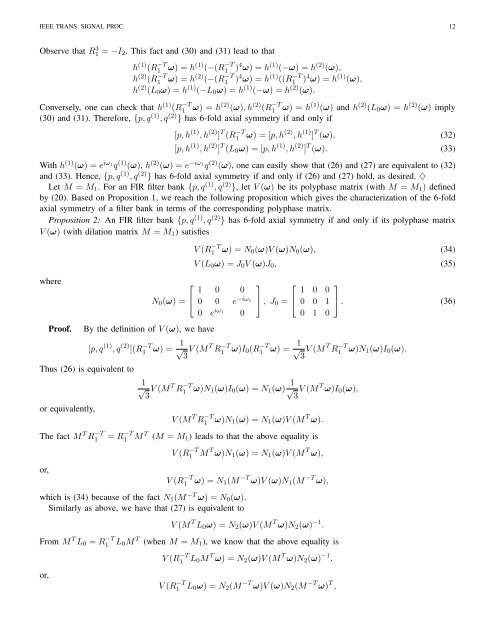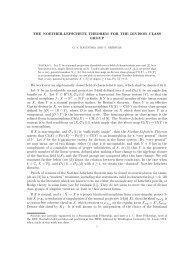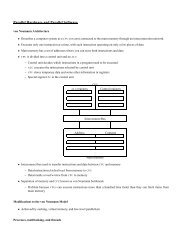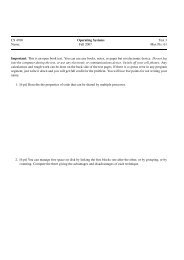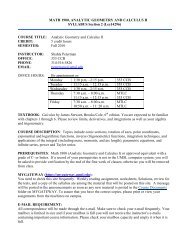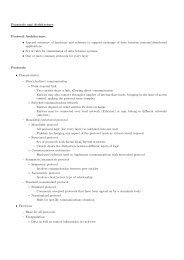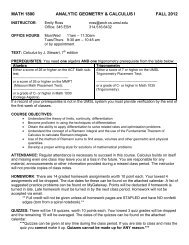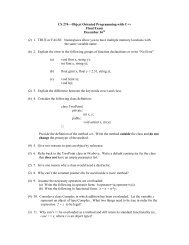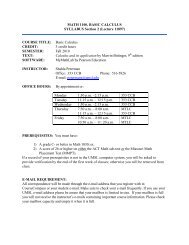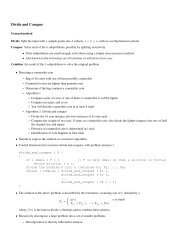here - UMSL : Mathematics and Computer Science - University of ...
here - UMSL : Mathematics and Computer Science - University of ...
here - UMSL : Mathematics and Computer Science - University of ...
You also want an ePaper? Increase the reach of your titles
YUMPU automatically turns print PDFs into web optimized ePapers that Google loves.
IEEE TRANS. SIGNAL PROC. 12<br />
Observe that R 3 1 = −I 2. This fact <strong>and</strong> (30) <strong>and</strong> (31) lead to that<br />
h (1) (R1 −T ω) = h (1) (−(R1 −T ) 4 ω) = h (1) (−ω) = h (2) (ω),<br />
h (2) (R1 −T ω) = h (2) (−(R1 −T ) 4 ω) = h (1) ((R1 −T ) 4 ω) = h (1) (ω),<br />
h (2) (L 0 ω) = h (1) (−L 0 ω) = h (1) (−ω) = h (2) (ω).<br />
Conversely, one can check that h (1) (R1 −T ω) = h (2) (ω), h (2) (R1 −T ω) = h (1) (ω) <strong>and</strong> h (2) (L 0 ω) = h (2) (ω) imply<br />
(30) <strong>and</strong> (31). T<strong>here</strong>fore, {p, q (1) , q (2) } has 6-fold axial symmetry if <strong>and</strong> only if<br />
[p, h (1) , h (2) ] T (R1 −T ω) = [p, h (2) , h (1) ] T (ω), (32)<br />
[p, h (1) , h (2) ] T (L 0 ω) = [p, h (1) , h (2) ] T (ω). (33)<br />
With h (1) (ω) = e iω 1 q(1) (ω), h (2) (ω) = e −iω 1 q(2) (ω), one can easily show that (26) <strong>and</strong> (27) are equivalent to (32)<br />
<strong>and</strong> (33). Hence, {p, q (1) , q (2) } has 6-fold axial symmetry if <strong>and</strong> only if (26) <strong>and</strong> (27) hold, as desired. ♦<br />
Let M = M 1 . For an FIR filter bank {p, q (1) , q (2) }, let V (ω) be its polyphase matrix (with M = M 1 ) defined<br />
by (20). Based on Proposition 1, we reach the following proposition which gives the characterization <strong>of</strong> the 6-fold<br />
axial symmetry <strong>of</strong> a filter bank in terms <strong>of</strong> the corresponding polyphase matrix.<br />
Proposition 2: An FIR filter bank {p, q (1) , q (2) } has 6-fold axial symmetry if <strong>and</strong> only if its polyphase matrix<br />
V (ω) (with dilation matrix M = M 1 ) satisfies<br />
V (R1 −T ω) = N 0 (ω)V (ω)N 0 (ω), (34)<br />
V (L 0 ω) = J 0 V (ω)J 0 , (35)<br />
w<strong>here</strong><br />
Pro<strong>of</strong>.<br />
⎡<br />
N 0 (ω) = ⎣<br />
By the definition <strong>of</strong> V (ω), we have<br />
1 0 0<br />
0 0 e −iω 1<br />
0 e iω 1<br />
0<br />
⎤<br />
⎡<br />
⎦ , J 0 = ⎣<br />
1 0 0<br />
0 0 1<br />
0 1 0<br />
⎤<br />
⎦ . (36)<br />
[p, q (1) , q (2) ](R −T<br />
1 ω) = 1 √<br />
3<br />
V (M T R −T<br />
1 ω)I 0 (R −T<br />
1 ω) = 1 √<br />
3<br />
V (M T R −T<br />
1 ω)N 1 (ω)I 0 (ω).<br />
Thus (26) is equivalent to<br />
or equivalently,<br />
1<br />
√<br />
3<br />
V (M T R −T<br />
1 ω)N 1 (ω)I 0 (ω) = N 1 (ω) 1 √<br />
3<br />
V (M T ω)I 0 (ω),<br />
V (M T R −T<br />
1 ω)N 1 (ω) = N 1 (ω)V (M T ω).<br />
The fact M T R −T<br />
1 = R −T<br />
1 M T (M = M 1 ) leads to that the above equality is<br />
or,<br />
which is (34) because <strong>of</strong> the fact N 1 (M −T ω) = N 0 (ω).<br />
Similarly as above, we have that (27) is equivalent to<br />
V (R −T<br />
1 M T ω)N 1 (ω) = N 1 (ω)V (M T ω),<br />
V (R −T<br />
1 ω) = N 1 (M −T ω)V (ω)N 1 (M −T ω),<br />
V (M T L 0 ω) = N 2 (ω)V (M T ω)N 2 (ω) −1 .<br />
From M T L 0 = R −T<br />
1 L 0 M T (when M = M 1 ), we know that the above equality is<br />
or,<br />
V (R −T<br />
1 L 0 M T ω) = N 2 (ω)V (M T ω)N 2 (ω) −1 ,<br />
V (R −T<br />
1 L 0 ω) = N 2 (M −T ω)V (ω)N 2 (M −T ω) T ,


